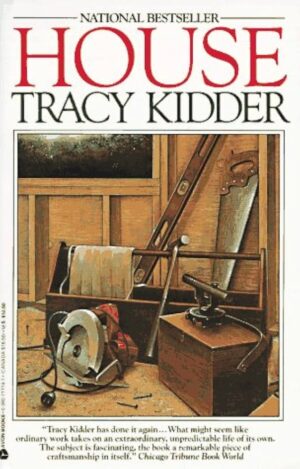Brick by Brick: Tracy Kidder’s “House”
 This year, Tracy Kidder’s House, a work of narrative nonfiction, is 40 years old. It’s worth looking back at it for several reasons, among them that a book like this would be unlikely to appear today.
This year, Tracy Kidder’s House, a work of narrative nonfiction, is 40 years old. It’s worth looking back at it for several reasons, among them that a book like this would be unlikely to appear today.
For those unfamiliar with Kidder, he’s one of the legendary American nonfiction writers. He won the Pulitzer Prize for his second, evocatively-titled, book, The Soul of a New Machine, published in 1981. It was, at the time, required reading for anyone interested in the new-fangled computer technology. (For example, people who were putting 5¼-inch floppy disks in their Commodore 64 and playing Bubble Bobble. That is, if they couldn’t afford an Apple II.) Reading like a fast-paced thriller, Kidder followed a team of engineers at Data General Corp. rushing to get a new microcoputer to market. Sleepless nights and clashing egos in this race-to-market versus do-it-right saga. (One of the mottos of the colourful design team’s lead, Tom West, was: “Not everything worth doing is worth doing well.” ) It remains, today, among the best books, and certainly the most creative, documenting the early days of computing..
Next came House. Let’s try to imagine the pitch session. “It will be a dramatic, brick-by-brick chronicle of an upper-middle-class couple, an architect, and the four builders who make up the firm, Apple Corps., as they struggle to construct… a house. I will capture all of the day-by-day frustrations and anxieties, challenges and triumphs, as even the building of a staircase becomes a battle of wills.”
The early ’80s were a more freewheeling time in publishing. It’s next-to-impossible to imagine selling this idea in today’s commercial environment. That said, and even though there are moments when even my attention lagged, Kidder excels at fly-on-the-wall reporting and House delivers his usual level of intimacy as he burrows inside the heads of his characters. The couple are Jonathan and Judith Souweine, a lawyer and psychologist, respectively. They want to build their first house on a property in central Massachusetts. Bill Rawn, a classic visionary architect, excelled at a couple of careers and, in mid-life, has just launched his own architectural practice, with this being his first house. The builders — Jim Locke, Richard Gougeon, Alex Ghiselin, and Ned Krutsky — are interested in high-quality workmanship even if it comes at the expense of contract management (which doesn’t stop them from agonizing about it).
Building a house is a blend of dreams and hard-boiled financials. (There is tension throughout the book over a concession in the price that may cost Apple Corps money.) Mostly it’s what happens when people with dreams engage dreamers trying to earn a living, everyone committed to a project that represents different things to each individual but is equally important to them all.
Take the architect when he first sees his blueprints become tangible. “The house looks like a pair of adjacent boxes, one large, one small, a child’s outsized building blocks, with many rectangular holes in the plywood walls. To Bill Rawn, though, it is a new reality. Bill has made other inspections while Apple Corps built, but the house lacked shape the last time he saw it. Now Bill can see the refined adult in the gawky child, and he is so moved he can barely speak at first.”
Kidder’s character sketches are and example of how writers of creative nonfiction apply the techniques of novelists to real life. “[Jim] Locke is wearing jeans and work boots and an old brown jacket, a workingman’s uniform. His clothes are clean and he is clean-shaven. He has straight brown hair, neatly trimmed and combed, and a long, narrow jaw. There is a delicacy in his features. You can imagine his mother in him. He has a thoughtful air. He studies his transit a moment, laying two fingers against his lips. Then as he bends again to the eyepiece, he wipes the hair off his forehead and for a moment he looks boyish and defiant…”
It’s not surprising that readers get the sense Kidder identifies especially strongly with the builders. In his book, Good Prose: The Art of Nonfiction, he described his own obsessive craftmanship, which I relate to. “While doing my research for what became House, I found myself wondering where the lumber in the frame of the building came from. I followed it back, as it were, to the Big Woods of Maine: the logging camp where the trees had been felled and the mill where they were sawn…”
In this exchange of dialogue, Kidder captures a misunderstanding and lets readers fill in the nuances implied.
“Jim has another question on another day. He find [Judith] in the kitchen. ‘The second floor is all carpet, right?’
‘No way, Jose,’ she says. ‘It is carpet in the bedrooms, tile in the bath, and oak everywhere else.’
Jim drops his pencil.
‘You obviously are surprised.’
‘Oh,’ he says. ‘Ohhhh. That would have made a lot of difference. The underlayment on the second floor is all for carpet.’
She understands. He had planned carefully for carpet. ‘Oh, dear. I feel bad you didn’t know that.’
‘I do, too.’
‘Is it in the contract?’
‘It ought to be.'”
That a book like this is unlikely to be produced today is all the more reason to add it to your reading list.